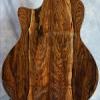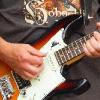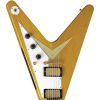Leaderboard
Popular Content
Showing content with the highest reputation on 04/02/2021 in all areas
-
You'll want to hear this. Now read this http://www.terrykath.com/tks-gear Some advice regarding the wah (a crybaby supposedly but i would try the Vox as well) set the mix to around 75%. It makes it a little more orgainic. Aside from the article, I've seem him live with a Orange amp. The isolated track sounds like he as some kind of fuzz on it. More than likely a Fuzz Face. Could be a Big Muff too. Try both. Amp wise I'd start with the Fender Bassman or 5C3 Tweed Deluxe (Tweed Deluxe, Fullerton respectively)2 points
-
Def Leppard used the X100 for the recording of Hysteria, but used a modified Rockman XPR processor for the tour (since it handles all the switching of sounds via MIDI). I always find it interesting when people talk about "THE" Boston tone.... my response is always, "Which one?" Tom used many different tones over the decades. Each song usually had its own tones, and multiples of different tones were layered up or used for different parts in a song. For example, on "More Than A Feeling" there are 2 different distorted tones used in the chorus rhythm (and each are double tracked), another one used for the distorted rhythm during the solo, and another less distorted rhythm used for the very last chord of the solo. The clean electric tone is run through a cocked wah as well for a very low-fi sound. For the leads, there's a lead tone for the fills, but then the main lead solo lines have a different tone all together (a really nasally cocked wah AFTER the gain stage). BTW, there are actually 6 tracks played (3 part harmonies double tracked) for the last 4 notes of the lead solo!! And that's just for ONE song. The other songs on that album use different tones too, as do the songs on all the other albums. The first 2 albums mostly used a Marshall Plexi, and then Third Stage was mostly Rockman IIB, X100 and Model 100 Sustainor. Walk on was mostly Model 200 Sustainor and the Ultimatum Distortion Generator. Since then, he's mostly been using a VERY rare "Rev 20" revision of the Model 200 Sustainor for some time now, both live and in the studio. Like, maybe a dozen or so were modified at the factory? Yeah, THAT rare!! I've seen them go for upwards of $5,000 IF you can find one. They do sound quite different from your run of the mill Sustainor... more gain, more bite, and the auto-clean works very good. I can do the Rev 20 mod on a Model 200 Sustainor, but it takes me like 17 hours to do it. Very intensive!!!1 point
-
1 point
-
Dry lubes seem like a safer bet in general. They have a tendency to gather less dirt and dust and stay put very well. When mine started to squeak I used the one at the link below and one application(just loosened things up a bit with the big Allen wrench, applied, and retightened, did not have to open chassis) has lasted for years and still going. https://www.amazon.com/gp/product/B000C17R7Q/ref=ppx_yo_dt_b_search_asin_title?ie=UTF8&psc=11 point
-
Why would you need to get a pot and do the tests? We've given you the facts, it's science, it's not debateable.1 point
-
I find that the Helix isn't good for non-guitar harmonies, especially "intelligent" harmonies (you enter the key of the song and get a properly pitched harmony at any interval(s) you require). Get a TC Helicon product, even if its an old used one. Those do a great job with vocal harmonies. I've used one on sax for years and it works great.1 point
-
I'm kind of lost with what you're trying to achieve now.1 point
-
Thank you. I'm using a set of Bose Noise canceling headphones (wired, of course). I double checked my global settings and they were as you stated. I've now submitted a support ticket.1 point
-
Not exactly... IR = Impulse Response, and indeed, it does 'capture' FR (Frequency Response), but it does a LOT more more... It will also capture 'everything' around it. Ex: If you had an amp and played the sound "tikilliki" through it, and it sounded like "tekesseke" because it it has a bad woofer; well, if you generated an IR, the IR would make it sound like if it was played through the amp. Basically; it captures "the system"; it captures how a cab + a mic makes the sounds sound when you're playing 'through' them. The simplest way to visualize the concept, imagine a recording studio, where they have a Marshall Cab setup with a microphone at 2 inches at 3 degrees; well, if you plugged an amp on the cab and recorded the sound recorded by the microphone, it would record the way the cab + mic sound. Well, that's exactly the IR. In theory, if you played the sound through the cab + mic and recorded the mic output, you would get the exact same sound by recording the amp signal and running it through the IR. https://en.wikipedia.org/wiki/Impulse_response1 point
-
The mix is really off. I can barely hear your voice mic and the cymbals overpower everything. I stopped listing after a couple of minutes so I don't know if it improved later on.1 point
-
I would like to correct the position for studio recording slightly. You can record additional tracks in sync if you correctly set the latency compensation in your DAW, and can live with a second or so lag between pressing play/record and the music starting. The process to get the correct settings is a little laborious but on Reaper and Windows for me when set as 12 in and 2 out you have to turn off the Audio driver reported and set Output Manual Offset = 71067 and Input Manual Offset = 26827. As you can see that is nearly 100,000 samples of compensation which with a 48k sample rate is 2 seconds of latency. But once set you can listen to previously recorded tracks while tracking new ones without having to align the tracks afterwards.1 point
-
If you are using the expression pedal toe switch to alternate between wah and pitch wham for example it sounds to me like you may need either a second pitch block detuned a half step that becomes active when you switch to the wah. Or, I suppose, depending on how you were using the pitch wham you could clear the bypass assignment for the pitch wham so it stays active when switching to wah. Or you could get a Variax :-)1 point
-
Don't know what else I can do for you. You must be doing something wrong, but without putting my hands on your rig, I can't tell you what it is. What comes through the headphones is what comes out of the L/Mono Output and the Right Output. If both outputs work on a normal preset, what I said above, which works on mine, should work on yours. Check it all again, make sure (with a multimeter) that ALL of your cables, even the ones you're sure of, are working, and connected correctly.. That's all I got!1 point
-
1 point
-
GregJ, is there an updated version of your Excel-based list of the various Helix models that includes the 3.01 update? Thanks!1 point
-
The Firehawk FX is outstanding in every way except one, "NO PC/MAC editing software, WHY? Some of us don't have an ipad or android device. Our laptops are as mobile as it gets. "PLEASE RELEASE A PC/MAC VERSION OF THE EDITOR SOFTWARE."1 point
-
I have a similar issue at the moment, updated the base unit no problem, went to update the TB516G and the updater program states "The Transmitter was not detected correctly". I have opened ticket with support and are being helpful, so far have suggested. 1. http://line6.com/support/page/kb/_/live-sound/relay-digital-wireless/how-to-update-relay-g7075-transmitter-and-rece-r807 Make sure you've installed the latest version of Line 6 Updater (v1.12) and try updating in offline mode. For this, please download the TB516G flash memory file v1.03 from our website: http://line6.com/software/ Connect the transmitter via USB to your computer, launch Line 6 Updater, don't login, choose "offline mode" instead. Then select the downloaded file and try to repeat the update. Also test it with different USB ports and another USB cable. Don't connect to an USB hub. If still not working, please test it with another computer, if possible. Which I have been through, when I try and connect same report. I suspect that is a driver type issue maybe specific to Windows 10 which I have also running on a surface pro. Attached are the event reports for the device, where something is not finalising with the driver install. It is also suggested that your remove the batteries from the Transmitter for an update and there is a 5 secs on/off reset should things not go to plan If you are not seeing anything in the updater window then the device driver has probably not installed correctly or you have a cable fault. If you look in Devices and Printers you should see and Unspecified device called USB-Serial (Single Channel) - this is what mine registers as anyway. If you right click and run the trouble shooter it reports the device is a composite older USB that may not work with USB 3.0. So I'm off to find a USB 2.0 port on another machine! If I solve it or Support come up with something then I will post1 point
-
I simply assign both the "Bypass" and "Position" to EXP Pedal 2 and it auto-engages when I rock the pedal. It disengages when I return the pedal position back to "0". No switch needed. It works beautifully! Hope this help you.1 point
-
Thanks, I've already mentioned that I'm just as interested in the science and engineering of music and music equipment as I am in shutting up and playing my guitar. And by the way, Frank was at the forefront of musical science and engineering for his entire career and if you're suggesting that I should model my approach to his, well then I guess I have to start asking even more questions.0 points
This leaderboard is set to Indiana - Indianapolis/GMT-04:00







